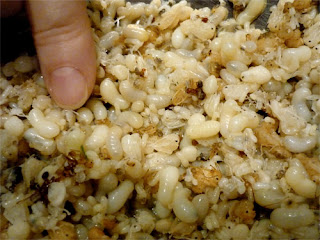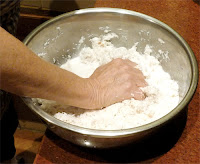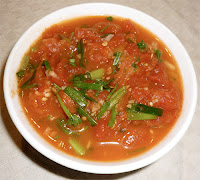Before I left for Italy this summer, a small band of Women’s International Group (WIG) ladies had a meeting with the United Nation’s Office of Drugs and Crime (UNODC) about a pilot project to help the women of Somsanga, Laos’s largest drug rehab center situated a few miles outside of Vientiane. UNODC already had vocational training programs in place for the men – t-shirt printing, carpentry shops, etc. but nothing for the women.
Stefan, the German coordinator, explained that the most successful programs were ones where the women could learn some skill that might translate into a job when they got out plus generate income for them while inside. We resolved to put our heads together and come up with a plan.
By the time I got back from Italy the plan was in high gear. Tomato and Onion Relish was going to be made at Somsanga, bottled and the sold at the annual WIG Bazaar in November. A gang of eight WIG women had signed up and had already narrowed down the recipe to two choices. One of the first things I did on getting back to Vientiane was to go to a dinner where we ate hot dogs and hamburgers with both relishes to decide which one we wanted to make.
Here’s the winning recipe:
Tomato Onion Relish
Ingredients:
- 4 kilos ripe tomatoes
- 1.5 kilos brown onions
- ½ cup of salt
- 1 litre of white vinegar
- ¾ cup of sugar
- 3 Tablespoons of curry powder
- ¾ teaspoon cayenne pepper
- 4 ½ teaspoons mustard powder
- Freshly ground black pepper
- 1 tablespoon cornstarch (optional)

- Method:
- Place tomatoes in boiling water briefly and then remove skins
- Remove core and chop into small chunks
- Peel and dice onions
- Place together in a bowl and sprinkle with salt
- Leave overnight in a cool place
- The following day, drain off liquid and discard.
- Place tomatoes and onions in a large saucepan.
- Add vinegar
- Slowly bring to a boil and then lower heat and simmer for ½ hour stirring occasionally
- Add sugar, curry powder, mustard powder, and cayenne.
- Add black pepper to taste
- Simmer for approximately 30 more minutes
- If the relish seems too watery, thicken with cornstarch mixed with cold water. Add slowly while stirring continuously
- Place relish in warm sterilised jars
- Cover and seal
Seems pretty straightforward, right? Oh, no, no, no dear reader, not at all.

First of all we never should have picked a recipe that begins “The day before...” because we were only at Somsanga one day a week. So we were either chopping everything as you see here at the center or we were chopping at a WIG member’s house and hauling it up there. Even going two days in a row was problematic since “Leave overnight in a cool place” was initially impossible because Somsanga had no fridge. (Later a fridge was available). So we had to schlepp it back to Vientiane and store it in someone’s fridge overnight. And we weren’t just making the amount in the recipe, we were tripling or quadrupling it.
Other trip-ups were the fact that Somsanga doesn’t really have a proper kitchen. No running water inside and just two gas burners to cook and sterilize jars on.
 The WIG ladies did all the purchasing of supplies but not as a donation, part of the project was to explain how a small cottage business works. Here’s our presentation explaining the costs of ingredients, jars and labels per jar and how much profit we hoped they would make after they paid us back IF we could bottle and sell 200 jars. No, none of us could actually write this by ourselves, the center gave us two interpreters to translate and they wrote this up. Capitalism at work.
The WIG ladies did all the purchasing of supplies but not as a donation, part of the project was to explain how a small cottage business works. Here’s our presentation explaining the costs of ingredients, jars and labels per jar and how much profit we hoped they would make after they paid us back IF we could bottle and sell 200 jars. No, none of us could actually write this by ourselves, the center gave us two interpreters to translate and they wrote this up. Capitalism at work.Because there wasn’t enough work for everyone when we were cooking and bottling the relish, we brought art supplies up and had the women and girls design the label. This was done in the “recreation” room which is basically an empty space with a ceiling mounted television and a great big Buddha. We put all the designs up on the wall and then they voted for their favorite. Democracy at work.

One week we left a lot of shiny foil paper behind and when we came back they’d transformed them into amazingly intricate mobiles that they decorated their rooms with. Lao women’s small motor skills are phenomenal which is why they’re such great weavers.
In the middle of all this I got my monthly e-mail from George Soros’s Open Society Institute pillorying the governments of Thailand, Cambodia and Laos for their drug rehab programs as illegal forced incarceration without trial. This gave me pause. Yes, it’s true the rehab center is really a prison, in fact the building was originally a “re-education camp” after the revolution. It had been run by the military but was now under the auspices of the Mayor of Vientiane – a definite improvement. Women end up in Somsanga most of the time because either their families or their village chief drop them off. They remain there until someone in charge decides they can be let go – minimum stay six months.
Most of the drug abuse in Laos is methamphetamines. An ethnic group in northern Myanmar (Burma), the Shan, manufacture it to finance their war with the military junta. They want their own state. Much of the product is headed for more populated countries like Thailand and Vietnam but it gets couriered through Laos. The sad part is that often times women end up hooked without having a clue what they’re taking. They think of it as an energy pill enabling them to work extra shifts at a garment factory or stay up all night studying. But Red Bull it ain’t.
In the end, I decided that going to Somsanga and, hopefully, making a tiny difference and bearing witness to what the place was like was better than staying atop my high horse and rejecting it. What do you think?
 This is Nongnut Foppes, originally from Thailand she married a Dutch man and lived in Holland for a few years. When they moved to Vientiane she missed yoghurt so much she started a small business supplying us “falang” with what I have to say is the best yoghurt I’ve ever eaten. Her passion fruit yoghurt is sublime. She sold us the jars and when they were filled we brought them back to her and she showed us how to seal them with a hot gun.
This is Nongnut Foppes, originally from Thailand she married a Dutch man and lived in Holland for a few years. When they moved to Vientiane she missed yoghurt so much she started a small business supplying us “falang” with what I have to say is the best yoghurt I’ve ever eaten. Her passion fruit yoghurt is sublime. She sold us the jars and when they were filled we brought them back to her and she showed us how to seal them with a hot gun. Here at last is the finished product with label and seal.
And here is the Somsanga booth at the WIG Bazaar. The guy is a German volunteer and the women in the picture are from the center and were allowed to come down for the day to sell it. I had pushed for the woman standing to be allowed to do this since she was one the hardest working women on the project.
We’ve not yet sold all 200 jars but we made back our costs with money to spare and I believe in the end we’ll sell the whole lot. We asked Stefan how the profit would be divided. He said in the past they’ve given the participants a choice. The money can be held for when they get out. Or they can use it to improve their diet while inside. Or they can pay to have a party. And naturally, being Lao, they always pick a party. Maybe that’s why I’m here.
















































